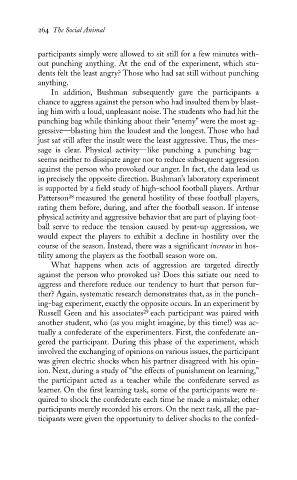Page 282 - The Social Animal
P. 282
264 The Social Animal
participants simply were allowed to sit still for a few minutes with-
out punching anything. At the end of the experiment, which stu-
dents felt the least angry? Those who had sat still without punching
anything.
In addition, Bushman subsequently gave the participants a
chance to aggress against the person who had insulted them by blast-
ing him with a loud, unpleasant noise. The students who had hit the
punching bag while thinking about their “enemy” were the most ag-
gressive—blasting him the loudest and the longest. Those who had
just sat still after the insult were the least aggressive. Thus, the mes-
sage is clear. Physical activity—like punching a punching bag—
seems neither to dissipate anger nor to reduce subsequent aggression
against the person who provoked our anger. In fact, the data lead us
in precisely the opposite direction. Bushman’s laboratory experiment
is supported by a field study of high-school football players. Arthur
28
Patterson measured the general hostility of these football players,
rating them before, during, and after the football season. If intense
physical activity and aggressive behavior that are part of playing foot-
ball serve to reduce the tension caused by pent-up aggression, we
would expect the players to exhibit a decline in hostility over the
course of the season. Instead, there was a significant increase in hos-
tility among the players as the football season wore on.
What happens when acts of aggression are targeted directly
against the person who provoked us? Does this satiate our need to
aggress and therefore reduce our tendency to hurt that person fur-
ther? Again, systematic research demonstrates that, as in the punch-
ing-bag experiment, exactly the opposite occurs. In an experiment by
29
Russell Geen and his associates each participant was paired with
another student, who (as you might imagine, by this time!) was ac-
tually a confederate of the experimenters. First, the confederate an-
gered the participant. During this phase of the experiment, which
involved the exchanging of opinions on various issues, the participant
was given electric shocks when his partner disagreed with his opin-
ion. Next, during a study of “the effects of punishment on learning,”
the participant acted as a teacher while the confederate served as
learner. On the first learning task, some of the participants were re-
quired to shock the confederate each time he made a mistake; other
participants merely recorded his errors. On the next task, all the par-
ticipants were given the opportunity to deliver shocks to the confed-

